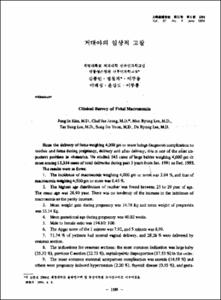KUMEL Repository
1. Journal Papers (연구논문)
1. School of Medicine (의과대학)
Dept. of Obstetrics & Gynecology (산부인과학)
거대아의 임상적 고찰
- Keimyung Author(s)
- Kim, Jong In; Lee, Tae Sung; Yoon, Sung Do; Lee, Du Ryong
- Department
- Dept. of Obstetrics & Gynecology (산부인과학)
- Journal Title
- 대한산부인과학회잡지
- Issued Date
- 1994
- Volume
- 37
- Issue
- 6
- Abstract
- Since the delivery of fetus weighing 4,000 gm or more brings dangerous complication to mother and fetus during pregnancy, delivery and after delivery, this is one of the most important problem in obstetrics. We studied 545 cases of large babies weighing 4,000 gm or more among 13,334 cases of total deliveries during past 3 years from Jan. 1991 to Dec. 1993. The results were as flows: 1. The incidence of macrosomia weighing 4,000 gm or more was 3.64%, and that of macrosomia weighing 4,500 gm or more was 0.45%. 2. The highest age distribution of mother was found between 25 to 29 year of age. The mean age was 28.90 year. There was no tendency of the increase in the incidence of macrosomia as the parity increase. 3. Mean weight gain during pregnancy was 14.78 Kg and mean weight of pregravida was 55.14 Kg. 4. Mean gastational age during pregnancy was 40.02 weeks. 5. Male to female ratio was 194.60:100. 6. The Apgar score of the 1 minute was 7.92, and 5 minute was 8.99. 7. 71.74% of patients had normal vaginal delivery, and 28.26% were delivered by cesarean section. 8. The indications for cesarean sections; the most common indication was large baby (25.32%), previous C-section(22.73%), cephalopelvic disproportion(17.53%) in the order. 9. The most common maternal antepartum complication was anemia (14.68%) and others were pregnancy induced hypertension(2.20%), thyroid disease (0.55%), and gestational diabetes mellitus(0.37%). 10. The most common maternal complication of intrapartum and postpartum period were vaginal laceration (4.40%) and postpartum beeding(3.85%). 11. Neonatal complication in macrosomia were cephalhematoma (1.47%), brachial plexus paralysis (0.55%), and fracture of clavicle (0.14%). Perinatal death was not visible.
- Alternative Title
- Clinical Survey of Fetal Macrosomia
- Publisher
- School of Medicine
- Citation
- 김종인 et al. (1994). 거대아의 임상적 고찰. 대한산부인과학회잡지, 37(6), 1186–1193.
- Type
- Article
- ISSN
- 0494-4755
- Appears in Collections:
- 1. School of Medicine (의과대학) > Dept. of Obstetrics & Gynecology (산부인과학)
- 파일 목록
-
-
Download
 oak-bbb-1509.pdf
기타 데이터 / 479.46 kB / Adobe PDF
oak-bbb-1509.pdf
기타 데이터 / 479.46 kB / Adobe PDF
-
Items in Repository are protected by copyright, with all rights reserved, unless otherwise indicated.